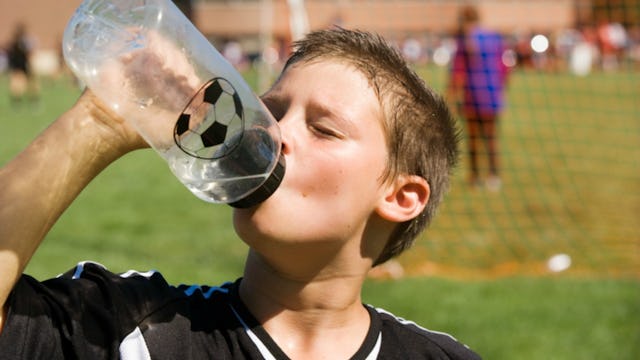Heat Stroke Can Be Deadly. Here's How To Recognize The Signs And Treat It.

Summer’s an awesome time of year for kids and parents, and it sure beats the icy snap of winter days. But it also presents us with its own challenges. We’ve got to watch our young swimmers like hawks, and make sure to be diligent AF about pool safety. Sun protection isn’t something anyone should take lightly either.
But one aspect of hot weather that not everyone is aware of is heat stroke. And especially if you’ve got an athlete or a kid who is active outside on hot summer days, you must be aware of the dangers of heat stroke — and how to recognize and treat it. This is no joke, folks.
RELATED: What To Know About Heat Exhaustion In Kids, Including Why They’re More Susceptible
Any kind of overheating can become dangerous if not treated. But there is one condition that parents of athletes and active kids need to be particularly conscientious about, and that is a condition called exertional heatstroke (EHS).
EHS is actually a medical emergency and if not treated, it can lead to organ failure or death. What’s more, according to The Journal of Applied Physiology, it’s the third leading cause of death among high school athletes. That is absolutely terrifying, if you ask me.
So what is EHS, and how does it happen?
Dr. Troy Madsen from the University of Utah describes it like this. Your kid is playing sports outside on a hot summer day, or is attending a sports camp. They’re out there on the field trying to do their best, wanting to impress their friends, their parents, their coaches. Even if they start to feel some of the signs of heat exhaustion (lightheaded, dizzy, nauseous), they might push that aside just so they can perform well.
And the problem is that their coaches — or even parents — might not be fully aware of the situation either. And not recognizing or treating it during its early signs is what leads to more dangerous symptoms.
“Hopefully coaches are aware of it, but you’ve got to figure too, these coaches have 30, 40, 50 kids out there,” explains Dr. Madsen. “They can’t watch every one and know exactly what they’re feeling so, yeah, hopefully they’re aware, but definitely the kids, they need to let the coach know when they’re just not feeling quite right.”
This is why it’s SO important to educate our kids, ourselves, and our coaches about the signs of heat stroke. In terms of signs, Dr. Madsen explains that first you are likely to feel signs of heat exhaustion, which is common enough. Those signs include dizziness, nausea, and “just not feeling quite right.” That is a good time to drink some water, rest, and take a break from the game.
Because if not treated, heat exhaustion can progress to EHS (heat stroke) – which again, can be deadly.
“Heat stroke is when it gets dangerous,” explains Dr. Madsen. “[W]e’re talking body temperatures of about 105 degrees and in that situation we’re often times seeing people pass out, they’re unresponsive. That’s when they’re at risk for organ failure and that’s when it gets very serious.”
Other signs of serious heat stroke, according to Children’s Hospital Colorado, include vomiting, cramps, excessive sweating, dry mouth and dehydration, headache, looking or seeming “off,” not being able to walk, low blood pressure, fast pulse, and quick breathing.
The good news is that if your child is beginning to show signs of heat stroke, they have a 100% chance of survival if you treat their symptoms within 10 minutes of symptoms. The University of Connecticut has a really good “cheat sheet” for what immediate measures you can take to mitigate these risks. Ready?
Here’s what you do:
1. Give your kid an ice bath. Yep: remove all their clothing and athletic equipment. Immerse them in a tub or stock tank (like one of these) with water and ice. You want to get the water to 35–58°F, and you can periodically add extra ice in order to keep it cool.
2. If you are not able to do an ice bath (there aren’t tubs available on most athletic fields), take your kid to a “shaded, cool area and use rotating cold, wet towels to cover as much of the body surface as possible,” explains the University of Connecticut.
3. Make sure to maintain your child’s breathing passageways and circulation.
4. Start the initial cooling process first (ASAFP), and then call 911 (also ASAFP).
5. As you are waiting for the EMT to arrive, continue your cooling measures until your child’s temp goes down to 101–102°F, and also monitor their vital signs.
Again, these are things that we parents need to learn, but we also need to teach our kids. They should be able to recognize the early signs within themselves, take proper precautions, and, of course, be able to lend a helping hand to a fellow player should that child show signs.
Prevention is key. Make sure that if you child will be playing in the heat, that they take plenty of water and shade breaks. They should dress appropriately and avoid playing if the heat index is in the danger zone. And they must know the signs of heat exhaustion and STOP to cool off as soon as they experience any symptoms.
Playing outside in the summer can be a wonderful, enriching experience. But we need to be safe. And our kids need to know that their well-being is more important than impressing anyone, pushing through to win a game, or anything else.
It’s cool to stay cool, and our kids (and us!) need to remember this most of all.
This article was originally published on